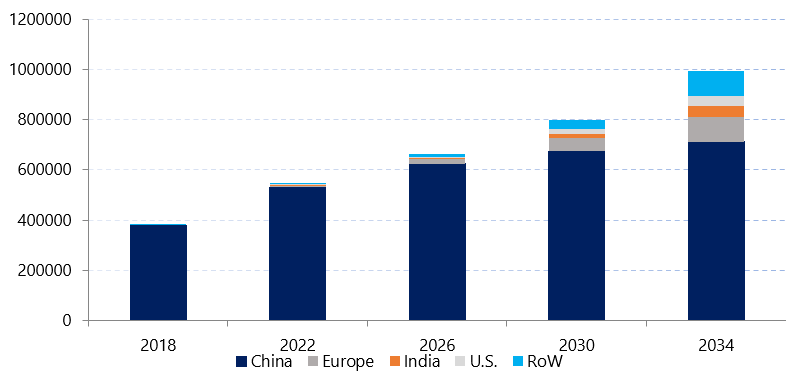Electric Buses and Cities: Can Innovation Lead the Way?
As of September 2019, there were just 2,255 zero-emission buses on the road. By 2030, this number is projected to increase to 3 million, or 7% of the global fleet. By 2040, electric buses are projected to represent 67% of new sales. This growth is driven by two factors: declining lithium-ion battery prices and government emission reduction commitments at both the local and national level.
Diesel transit buses emit high levels of NOx and generally operate in highly populated areas, creating both air quality and health concerns. Declining battery prices combined with a lower total cost of ownership (TCO) in comparison with diesel buses, has made electrifying bus fleets an attractive near-term strategy for municipalities to improve air quality and meet emission reduction commitments. In addition, countries such as China and South Africa view electric bus manufacturing as an opportunity to build an industry and create jobs around transport electrification.

Innovative Financing Methods
Currently, the dominant procurement model for electric buses is outright purchasing. Although declining, the average cost of an electric bus is 50% higher than a diesel bus, forcing transit operators to rely on government subsidies to bring the cost down. Although subsidies have supported the market so far, innovative financing models will be necessary to make electric buses more affordable and allow the market to survive when subsidies eventually dry up.
One strategy is leasing the battery. In December 2019, Proterra announced a battery leasing scheme in which Proterra retains ownership of the battery, removing the most expensive component from the upfront cost of the bus. The battery lease then becomes an operating cost, which can be paid for by reduced fuel costs.
Electric buses require engagement from utility companies, a situation which can create challenges as well as opportunities. In Virginia, Dominion Energy is bringing 50 electric school buses to 16 localities in the utility’s service area by the end of 2020. Using a dual-ownership model, Dominion offsets the additional capital costs of electric buses and charging infrastructure and, in return, using vehicle-to-grid (V2G) technology, they can leverage the batteries as distributed resources to balance intermittent solar and wind energy generation. When the buses are not being used for transport, the batteries can store energy generated by renewables and discharge that electricity back onto the grid during times of high demand and low renewable generation.
Software-Based, Data-Driven Solutions
A key challenge with operating electric buses is their current limited range. While diesel buses can run for nearly 700 miles on a full tank, battery powered electric buses are limited to 265 miles in range. In some cases, three to four electric buses have been necessary to operate a route previously serviced by one diesel bus. Not only does this create operational challenges, the cost of additional drivers chips away at the lower total cost of ownership. Operating a fleet of electric buses as a network, rather than a group of individual vehicles, requires more sophisticated routing and scheduling mechanisms than transit agencies have historically used. In addition, electric buses have more variables to control than diesel buses to maximize charge, such as battery health, state of charge, weather, terrain and driver behavior. Another challenge is charging. The most popular charging strategy is overnight depot charging, which can require expensive infrastructure upgrades and create high demand charges for large fleets. Some key innovations that are solving these challenges include:
Energy and vehicle management: Monitoring and analyzing battery health, vehicle location, driving habits and other onboard variables that impact bus performance. Viriciti provides a vehicle management platform that uses GPS-based automated vehicle location (AVL) to measure fuel and charge levels, driver activity (heavy braking, stops, etc.), vehicle status and location. The platform scores drivers to encourage more efficient driving patterns, which can increase range by up to 30%. The platform also generates automated maintenance notifications to prevent breakdowns and battery degradation.
Fleet management: Modeling and optimizing routes, charging, breaks and stops across a whole fleet. Optibus provides a SaaS platform that provides data-driven scheduling and routing for transit fleets to shave several percentage points off operating costs. Fleet routing has historically been done using Excel and other legacy software, but data-driven, software-based routing can integrate variables such as range, charging requirements and driver behavior and allow transit agencies to schedule routes in entirely new ways.
Charging management: Managing charging rates and state of charge across a fleet to reduce peak demand and enable vehicle-to-grid services. The Mobility House provides a platform to optimize fleet charging to reduce overall load and shift load; the platform also reduces infrastructure cost by minimizing grid connection and the amount of charging infrastructure needed. The platform takes in information such as state of charge for each bus and when the buses will need to operate. It then adjusts charging across the fleet to ensure that all buses aren’t charging at the same time. The platform can also be used to control bi-directional charging and enable vehicle-to-grid services. The company works with 7% of European bus fleets and has investments from industry leaders such as Alliance Ventures, Daimler and Mitsui.
Amply, a San Francisco-based startup founded in 2018, has developed a charging-as-a-service model that includes hardware-agnostic infrastructure support, software technology that optimizes and aggregates vehicle charging to minimize electricity costs, depot upgrade and utility interconnection management, debt financing for capital expenditures and resiliency planning. The comprehensive service, offered for a price-per-mile-driven fee, is meant to simplify the electrification process for fleets, which typically would need to build out these capabilities in-house.
Keep an Eye on…
By 2040, electric buses are projected to represent 67% of new sales, according to BNEF. To get there, software-based operational solutions plus new models and drivetrain innovations (such as fuel cell range extenders) will continue to be built out to provide solutions for the wide variety of operational and performance requirements needed by fleet operators. Electric buses will also begin to penetrate new geographic markets such as Africa, India and South America, which are expected to see some of the highest growth rates in the coming decade.
Some OEMs, such as Van Hool, Daimler and Hyzon Motors, have rolled out hydrogen fuel cell buses for testing and use in cities that require longer range and operations in low temperatures. Fuel cell buses may be part of the solution to reducing public transit emissions, but high upfront costs, total cost of ownership, low energy efficiency and lack of hydrogen refueling infrastructure are major challenges.


